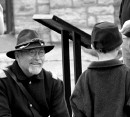The Woodruff Gun
Annotations to the Margreiter article.
Discoveries in the 1980s show all Woodruff shot were made of lead.
In an article in The Muzzleloading Artilleryman (now The Artilleryman magazine), Vol. 6, No. 2 (Spring 1985), Thomas S. Dickey presented updated information on the nature of Woodruff ammunition. He noted that the conventional wisdom that the Woodruff used iron grape shot balls has not been supported by recent finds in the field:
“In the fall of 1983, Van Abale was searching the wartime camp of Grierson’s Raiders in Baton Rouge, La. He unearthed four lead balls, caliber 2.1 inches and two canister bases with one layer of lead balls packed in sawdust.”
“The canister base was also 2.1 inches. At first it was thought that the large lead balls were Federal Navy case shot, but on closer examination the imprint of a wooden sabot and two crossing iron straps told the true story that these were indeed the projectiles for the Woodruff Gun.”
“The weight of the ball is 1 lb. 12 ozs., and with the sabot and straps probably weighed 1 lb. 14 ozs. Also unearthed were several minie balls for the Cosmopolitan Carbine which some of Grierson’s men had.”
“At about the same time as the Baton Rouge find, another discovery was made by Tracy Seabaugh on Shepherd’s Mountain near Pilot Knob, Mo. Near this town was the site of the Federal Ft. Davidson which had a battery of Woodruff Guns…”
“The surprise here was that the projectile wasn’t a round ball, but in the shape of a giant minie ball with nine rings. Three tired specimens have been unearthed there, along with two of the spherical pattern.”
“The conical projectile is 2.1 inch caliber, and weighs 2 lbs. 14 ozs. and has an extremely deep and wide cavity (1-13/16 inches deep) in the base which was designed to put the center of gravity so far forward that the projectile would always travel nose first, as a dart, even though it was fired from a smoothbore gun.”
Dickey cites the Herder correspondence and notes that the difference in height cited by Herder is exactly accounted for by the difference between the diameter of the round ball and the length of the conical projectile.

Conical lead artillery shot found on Shepherd’s Mountain at Pilot Knob, Missouri. Photo by Jack Mayes from the John L. Margreiter Collection, Missouri Historical Society Archives, St. Louis, Mo.
This explanation also occurred to me, but it assumes that 1) the powder charges were about the same for two projectiles of very different weights, which was not the practice at the time, and that 2) the ammunition boxes only contained solid shot. Woodruff specified that both solid shot and canister would be used in his guns, so the ammunition boxes would have been sized to accommodate both. The canister round without the powder bag would have been nearly 3 inches taller than the round shot with sabot. Extrapolating from the powder weight to shot weight proportions for standard smoothbore artillery rounds to estimate the powder charges for the Woodruff rounds and making some assumptions about the construction of the three types of Woodruff rounds, I have yet to arrive at a satisfactory result that produces the 1½-inch difference between the length of a conical shot with its powder bag and the box height needed to accommodate both the round shot and canister. More research is needed.
Click here for a discussion of the mathematics attempting to derive the 1½-inch difference in height cited in the Herder correspondence.


